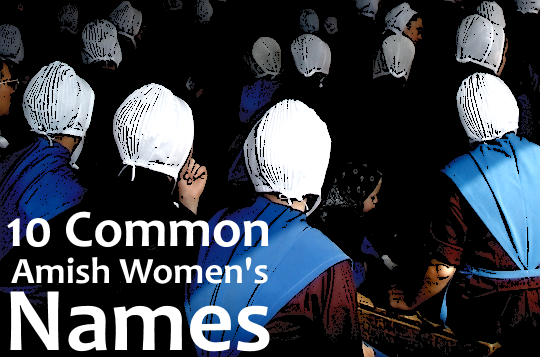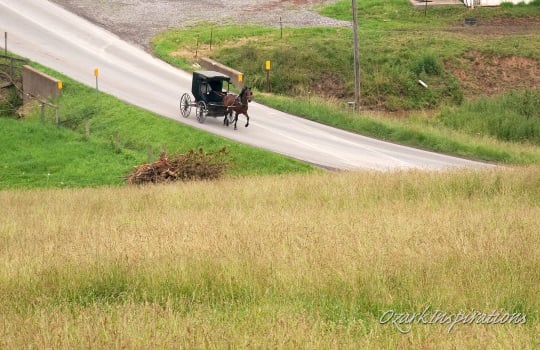5 Things Found in the Plainest Amish Communities
We had a look at icehouses last week, which you’ll find in plainer Amish settlements. What are some other things you’d expect to find in the most traditional Amish communities?
5 Features of the Most Traditional Amish Settlements
1. Outhouses – So we start with another type of “house”. Homes in the plainest Amish communities don’t have indoor plumbing.
This means outhouses, and for that matter, less frequent bathing (as a two-shower-a-day person, I would suffer greatly in this setup).
What some of us see as a quaint relic of yesteryear is an everyday toilet reality in these traditional church-communities.

As traditional waste disposal methods clash with modern ideas on sewage creating public health concerns, Amish outhouses have become flashpoints for controversy in recent years, for example in communities in Kansas and Ohio.
Outhouses can also be found in more progressive Amish places, where they are common at all types of Plain schools.
More mainstream Amish may also have an outhouse, for example for hired workers’ usage, as does a produce farming friend of mine in Lancaster County.
Otherwise, bathrooms in mainstream and progressive Amish homes resemble those in non-Amish homes, with linoleum flooring, tubs and showers, and typical bathroom decor.
2. Archaic textbooks – Though the 8th-grade cap on formal schooling is shared in common across Amish communities, this doesn’t mean Amish schools are all the same.
The approach to education varies based on the community and how the parents want to prepare their children for the future, taking expected occupation into account.
Karen Johnson-Weiner describes this in detail in Train Up a Child: Old Order Amish & Mennonite Schools.
Concerning plain Swartzentruber schools, “the school is not preparing children to interact socially with the dominant society; rather, the Swartzentruber Amish expect that their schools will socialize children to interact appropriately with others in their church-community.” (p. 34).
This has influenced the curriculum: “For the most part, the Swartzentruber Amish have simply continued the same educational practices they followed when their one-room schoolhouses were public, using the same texts their parents and grandparents found useful” (p. 34).
The texts Amish in these schools use are McGuffey’s Eclectic Primers and Readers, originally dating to 1836, and widely used through the 19th and early to mid-20th centuries.
Johnson-Weiner notes that the archaic schoolbooks contain vocabulary which is “of little use” to them in their own interactions or in business with non-Amish, offering example terms such as “telegraph”, “trolley”, “chiffonier”, and “jitney”.

Arithmetic texts have similarly outdated content including a reference to an “electric calculating machine.” Using these texts, Johnson-Weiner observes that they “[learn] an English no longer spoken by their non-Amish neighbors” (p. 59).
Not everyone uses McGuffey’s, but those who stick with them have reasons rooted in tradition and resistance to change. The plainest Amish have less expectation that their children will have occupations off the farm. Using outdated texts can help socialize them into a traditional Amish world.
In contrast, schools in progressive communities “[offer] a curriculum that prepares children to compete economically with their non-Old Order counterparts on a playing field that may be only marginally, if at all, in the Old Order world” (p. 131).
The example communities here are those where Amish employment in RV factories is common (northern Indiana; Centreville, MI).
3. Longer hair on men – You may have noticed that plainer Amish men tend to have longer locks. This is characteristic in plain communities (to go along with wider hat brims).
The hair will often be cropped close up front but grow down long over the sides, completely covering the ears.
I don’t want to post the photos here, but you can see examples of this online. You can also see what I mean in this profile shot of a Swartzentruber man in upstate NY:

While longer hair on men has in English society been linked to progressive counter-cultural communities (think the hippie movement or early-90s grunge culture), in Amish society longer hair (and beards) tends to be a marker of plainness.
The presence of smoking is another one of these counterintuitive markers – it’s traditionally more common in the more conservative groups.
Some of the more progressive Amish, such as those in New Order churches, are on the other end of things – sporting haircuts with rather close-cut sides, and neatly-trimmed beards.
4. Simpler, plainer businesses – What types of businesses are common in plainer communities?
As technology is more limited, and there are more barriers to reaching non-Amish buyers, that means plainer Amish tend to produce simpler products.
Basket and rug-making, sawmill lumber, and canned goods are common items coming out of plain Amish locations.
Technology used for furniture-making is simpler, as you can see in this Amish furniture shop with underfloor drive shaft in Ashland County, Ohio.

Whereas in tech- and business-progressive settlements like Lancaster County or Holmes County, you’re more likely to see Amish wholesaling and retailing high-end custom furniture, market stands selling fancily-packaged foods in urban areas, and construction crews doing sizeable commercial projects.
Greater openness to interacting online – either directly or through third-parties – also makes more progressive Amish communities’ business practices more sophisticated and varied.
5. Unconventional health practices – Health and medical practices among the Amish as a whole can be described as a mixed bag of conventional (hospital care, chiropractor visits) and traditional practices (midwife-aided births; natural remedies).
But certain of the most traditional or unorthodox practices – including those termed folk medicine, brauche, sympathy curing, or “powwowing” – are seen particularly in the plainest communities.
The authors of An Amish Paradox describe powwowing as such:
Patients may be suffering from physical or spiritual illnesses; powwowing has been used to remove curses and hexes as well. Some consider the basic ability of the braucher to be innate, a gift of God, but the secret techniques of the practitioner are in most cases learned from a person of the opposite sex…Powwowing, though controversial for some Amish, shows no signs of completely disappearing because of the increasing cost of mainstream medicine, the rise in acceptance of alternative medicine, and the continued belief by some in the reality of curses and hexes (p. 237).
The healing is achieved using charms or sacred words, or “other mysterious rituals.”

Another example where physical objects come into play: the metal copper figures in some practices, such as the practice of wearing copper, as in the form of a bracelet, in order to diminish the pain of arthritis. Copper wire can also be used in the practice of “drawing pain” away from the sufferer and into the ground (New York Amish: Life in the Plain Communities of the Empire State; p. 70).
Such practices are seen “most likely among very conservative groups,” with higher Amish such as New Order groups viewing them as “myths or ‘old wives’ fables'” (Paradox; p. 238).
On the other end of the spectrum, Amish – particularly those in larger mainstream communities like Lancaster County – have readily participated in medical research leading to important discoveries. These include studies revealing insights on secondhand smoke, asthma and the recent discovery of an “anti-aging” gene mutation in a community in Indiana.
Different ways of being Amish
These five selected signs mark a plainer approach to being Amish. Some of these things are physical signs which reflect group identity – how Amish mark themselves as different not only from English, but from other Amish as well.
Some practices are rooted in a belief in and resistance to discarding traditional ways which have served previous generations well (displaying admirable commitment to principle, or bull-headed stubbornness, depending on who you ask).
We could add many more markers to this list, such as lanterns on buggies, sparse yards and gardens, long church services, and so on.
Since plainer communities tend to resist change more staunchly, over time differences between Amish groups have emerged and been exacerbated. We’ll look at some features of the more progressive Amish settlements in an upcoming post.
Image credit: copper wire – Rosmarie Voegtli/flickr











the poisonous fruits of ignorance
It is sad to see the resistance to education, especially science education, leading some Amish to treat their diseases with useless and sometimes dangerous potions and procedures.
I was in a large Amish store in Michigan last summer, half the display space devoted to clothing and fabric and half to hundreds of quack remedies selling for outrageously high prices, like $30 and $40 for a tiny bottle of this or that kind of herbal concoction.
I admire the Amish for many things, but not for their determined resistance to knowledge of the natural world.
One of the best reviews I’ve seen of the complex Amish approach to health and medicine is the chapter dedicated to that topic in An Amish Paradox. I have noticed the popularity of unconventional treatments as well.
I think it’s a complex topic as there are a number of different categories of “unconventional” ranging from home remedies to the more dubious solutions (e.g., see the recent case of the Kentucky Amishman selling a homemade salve claiming to be “very good at removing tumors”). And of course plenty of Amish partake of conventional medicine and treatments as well. Personally I generally tend to be skeptical of the efficacy of this broad “unconventional” category but do not rule out beneficial effects completely. It is a sphere where hucksters have long operated and I think you do see that happening in Amish circles.
I know you noted that your first statement applies to “some” Amish but your final statement I’d say is a bit strong especially given their willingness to participate in research studies and support and use conventional medicine as well. It’s a mixed bag as I stated in the original post.
I shouldn’t have implied that all Amish resist modern medicine. I know very well that many accept it and use it. One Amish deacon, for example, told me last year about an Amish person in his district who ran up a hospital bill of more than $1 million and that it was paid off immediately in cash with the usual appeal to the community for donations. The Amish in this area of northern Indiana and southern Michigan are generally quite affluent.
What I was thinking of in my earlier comment was their broader resistance to scientific findings such as their belief in creationism.
What a minute, what does their “belief in creationism” have to do with the effectiveness of modern medicine? Is that belief hurting you? And what belief in creationism? I don’t know enough about the Amish to know if the Amish take the first chapter of Genesis literally, but so what if they do? I believe God created the world, but I also believe the 6 days in Genesis are not 24 hour days (why would God need to rest on the seventh day? He’s God). Personally, I think you’re viciously attacking a group your not part of for the sake of attacking that group. I LARGELY disagree with the Amish on many things, but I still have great respect for the vast majority of them
Natural medicine
Fact is people spend ridiculous amounts of money at hospitals to find themselves still without cures. Hospitals are cold, callous, rotten smelling places that still actually serve terrible food. There is still not a real cure there for cancer,for heart disease, lung disease, arthritis. Either way, from folk medicine or hospitals, people may or may not find cures. Natural medicine does work, yet there is a lot of misinformation. It works for me and I hope I never step in a hospital again.
traits
the beard is from Biblical Law/Commandment, it forbids putting steel to the jaw. (the upper lip & neck are not “jaw”). it also forbids “rounding the corners of the head.” Same with mandating covering the head. The purpose of many of the 613 Commandments was to keep the “people” from looking & acting like the “others” e.g. English or Goyim (gentiles) these same Laws are followed by many practicing Jews. Or any religious person adhering to Biblical Law. Brauche, interesting, I have always pondered its relationship to Hebrew/Biblical & current word in Judaism Baruchu. verbal Blessing of various types. Might be a coincidence but doubt it.
Interesting comments, and I agree about the expensive, very questionable potions.
I would also equate plain communities with non-rubberized wheels on their buggies.
But I’ve thought of perhaps having a type of “outhouse” in my back yard—a small shed with a composting toilet, perhaps? Sometimes its a LOOOONG walk (or run) to indoor plumbing, for young and old alike! 😉
Alice Mary
Textbooks
Re: textbooks, I’m weighing in as the daughter of 2 former educators; I earned a BSE in English so I am certified to teach but have not stepped into the classroom in forever. While some pertinent information may be lost without newer textbooks, I believe that the older textbooks required more from the students than the newer textbooks to achieve a passing grade, etc.
In the modern American culture, educators and parents have been decrying the newer curriculum labeled “Common Core”. I bet the more conservative Amish communities are, for the most part, educating students better overall.
Amish textbooks
I visited an Amish school last summer and was invited to examine the textbooks. There was not one on science.
Which community was that?
It was in Michigan, just over the border from the Indiana Amish region. I was part of a group taking a week-long course in Amish history and culture organized by Road Scholar.
I see, thanks Boyce. There are some quite conservative communities in the southern MI region…Branch County came to mind but that may be a bit further than you meant. But generally yes there’s not much science curriculum, or you might see subjects like health/nutrition.
You should do the 10 largest Amish populations by % of county.
Here are the first 5.
1. Holmes County, Ohio – 45%
2. LaGrange County, Indiana – 30%
3. Adams County, Indiana – 25%
4. Daviess County, Indiana, – 15%
5. Douglas County, Illinois – 11.5%
6. Clark County, Wisconsin – 9.9%
7. Milfflin County, Pennsylvania – 9%
8. Yates County, NY – 9%
9. Vernon County, Wisconsin – 8%
10. Lancaster County, Pennsylvania 7%
Emerging countries:
Munfordville County, KY – 5.6%
Monroe County, Wisconsin – 4.2%
Medford County, Wisconsin – 3%
Seneca County, NY – 2.1%
Lawrence County, TN – 2%
Most of these emerging counties have very small populations, and so it’s possible that they will one day surpass the more established communities.
I could be wrong on these numbers. Since they do not ask Amish their background in the Census, I am going by the reported languages spoken in those counties.
https://statisticalatlas.com/tract/Illinois/Douglas-County/952300/Languages
I should have included Moultrie County, Illinois in the list.
Nice idea, AJ, thanks. Are those some kind of census numbers, or from somewhere else? A study in 2012 had it at Holmes – 42% and LaGrange – 38%.
(“The Amish Population: County Estimates and Settlement Patterns of the Old Orders”, by Joseph Donnermeyer, Cory Anderson, and Elizabeth Cooksey)
https://amishamerica.com/5-amish-population-facts/
Hi Erik,
They’re from this website:
https://statisticalatlas.com/tract/Illinois/Douglas-County/952300/Languages
I do not know how accurate it is, but it seems to match census data I’ve seen. Also, it’s very hard to tell whether all those speakers are Amish or not, since I’m sure there a few non-Amish, such as Mennonites and non-Sectarians, etc, who speak the same language. But, I think it gives us an idea of their population by county.
Thanks AJ, yes that might skew it slightly in several places if it’s based off language given the Mennonite presence in some of those places. But looks like a lot of interesting info at that link.
On a similar note I recently had someone contact me from the Census Bureau asking about a certain East Coast state and wondering about how open the local Amish would be to participating in the census. So I guess they will be gearing up for that large undertaking fairly soon now 🙂
Your statistics are right about LaGrange County, IN.
https://statisticalatlas.com/county/Indiana/LaGrange-County/Languages
My initial post was based on old census data I found on Wikipedia.
The website has it at 36.9%.
Holmes County, OH.
The website has it at 48%.
https://statisticalatlas.com/county/Ohio/Holmes-County/Languages
Statistics on percents -
I beleive it is true that Oh has the largest Amish population. However, PA I beleive is the next one in line, as one talking from an Amish standpoint. Maybe I misunderstood what you’re saying?
Hi Esther, it’s true that OH and PA are the top two states by total numbers of Amish – but here we are talking about what % of each individual county’s population is Amish.
So for example Lancaster County has one of the top largest Amish populations (well over 30,000), but the county itself has over 500,000 people total, so the Amish portion is only around 7 or 8%.
Holmes County on the other hand also has one of the largest Amish populations by sheer numbers, but the total county population is only around 45,000, so it’s a much more “Amish” county in that sense.
I was just wondering why there is never any mention of the Amish in the Hardin and Marion Counties of Ohio.. I love going to the little home bakeries in the Kenton, LaRue, and Belfountain areas. You can actually get goods for true wholesale prices in these places because there us no middleman.
To Jenifer Margison
Hi Jenifer. Yes, I agree there are many wonderful small Amish stores and businesses in Hardin, Logan and a few near the border with Hardin and Marion County, Ohio. I’m glad you have discovered them- it’s mostly word of mouth. I’m very familiar with these Amish, and lived near them in my childhood. It’s interesting that the two communities are so very different- one being an extremely conservative Old Order Amish group which doesn’t use the orange triangle on their buggies, and the other being a very progressive New Order Amish group. I do really respect many of the people in both communities. When I attended church at the Belle Center New Order Amish church there in Logan County, they kindly added quite a bit of English into the service for my benefit. I really appreciated that, even though I did understand some German and brought my German-English Bible along to help.
I think they don’t get a lot of attention because they don’t live near large cities, they don’t have a lot of tourist traffic in these counties, & they do not really advertise or have a tourist industry like some other areas such as Holmes County, Lancaster County, etc. Most of them are not interested in bringing a lot of tourists to where they live– they want to keep living a slower, more peaceful lifestyle with a few customers. They don’t really have any type of entertainment, hotels or restaurants like in some of the more liberal communities.
Some of the stores are larger and have many very regular customers, others are smaller or more seasonal in nature. Every time I go to Hardin County I stop in at least one of the Amish stores because I really do get great deals there on everything! The local Old Order is bishop will not allow them to mark things up and make a big profit on things which they did not actually grow or physically make themselves, so you will see very good prices on things they buy wholesale to resell. I purchase my maple syrup there by the gallon (which they make) and still get an excellent quality and good prices compared to everywhere else.
I hope people will take the time for a good day trip north of Bellefontaine Ohio, and up through the countryside to the village of Pfeiffer Station. There are home stores, bakeries & other shops galore in that area! What they have on offer changes through the year- just look for the signs at the end of the driveway. The Pfeiffer Station General Store can even direct people to several of them, (don’t buy much there- get it directly from the Amish!) and if you find one, they will gladly tell you where others are. Have fun exploring, and drive slow!
Good post Eric. How about 5 Amish strengths for quality of life; high employment & literacy, low poverty, good life expectancy, low crime rates, and generally high rates of life satisfaction. John Booker made the wrong choice in Witness 🙂
Another good idea, thanks Dave 🙂
Outhouses
I was raised by my Church of the Brethren grandfather. The house that I grew up in did not have running water until FIVE years after I left!
Most of my friends were long time friends that an outhouse never really seemed that strange to them, but when my circle of friends increased, it became embarrassing to say the least.
We had a hand pump on the back porch with a ceramic sink that emptied through a pipe which led to the outside. The foot-wide “stream” flowed downhill to the fields. We had a dirt path to the outhouse and had to check for snakes on occasion.
When I had my first English Composition class in college, we had to write a descriptive document. I chose writing about our outhouse; got an A! Ours was pretty special as it had a cement floor and an actual toilet seat. Still it was pretty cold in the wintertime!
Amish window coverings
I have noticed that the Amish use window shades as window covers besides curtains at times . Which gives a very clean, streamlined , and uncluttered look to the windows . I love the look, and would like to know where they might purchase them from .